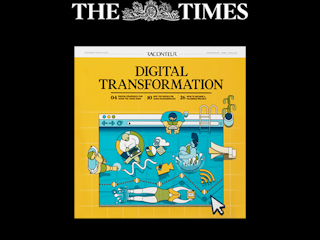2025-02-06
The traditional approach to ‘doing digital’ is broken. Slow time to market, low ROI and internal power struggles stifle innovation. Outdated funding models — tied to fixed projects rather than flexible products — make it harder to pivot, while legacy systems and siloed teams prevent businesses from responding to new opportunities. At the same time, top talent is drawn to organizations that embrace modern, agile ways of working. Without a shift in approach, companies risk falling behind.
What is a composable enterprise?
The term "composable enterprise", first coined by Gartner in 2014, has gained significant traction in recent years when discussing modular technology stacks, cloud-native platforms and microservices architectures. While these elements are key parts of the approach, reducing the concept to just its technological components misses the bigger picture. A composable enterprise is not merely a tech solution — it’s a business philosophy, a cultural shift and a strategic framework that unites technology with business objectives.
At its core, a composable enterprise is a digital-first business paradigm that is designed to adapt and evolve in response to changing market demands, customer expectations and technological advancements. It enables businesses to break down traditional silos, aligning digital-first, company-wide capabilities to better serve the entire customer journey across touchpoints — driving both growth and efficiency. The concept of the composable enterprise offers a strategic approach centered on adaptability, innovation and long-term growth.
What it IS:
-
A business-oriented interpretation of MACH principles (microservices, API-first, cloud-native, headless).
-
A dedication to embracing a digital-first business, fostering innovation, seamless interactions and agility.
-
A transformative shift empowering companies to stand out and thrive through integrated digital capabilities.
-
A driving force for transformation, enabling organizations to navigate uncertainties, future customer interactions and evolving journeys effectively.
-
For instance, consider e-commerce: It has evolved way beyond just a transactional website buy button to encompassing multiple channels, experiences and ecosystems. To excel, businesses require scalable modular commerce solutions that can adapt, grow and engage customers across touchpoints.
What it is NOT:
-
It's not something you can buy. It's a mindset.
-
It's more than just technological infrastructure; it encompasses capabilities, operating model, and skilled workforce.
-
It doesn't live on the outskirts of the company 'somewhere in digital'; it's at the core of the company and to be considered a similar asset to logistics, staff and warehousing.
Businesses (both B2C and B2B) have to become more customer-centric, innovative, resilient and growth-oriented, while at the same time save costs and be more efficient.
- Claes Justesen, Director of Digital Commerce & Composable Enterprise at Valtech
The three key drivers fueling this shift:
Delayed time-to-market and operational backlogs
Many organizations are burdened by outdated processes and rigid systems that slow their ability to bring products and services to market at pace. Long development cycles and mounting backlogs prevent businesses from responding quickly to market opportunities, giving more agile competitors the upper hand.
Geopolitical uncertainty
The global business environment is marked by volatility, from trade wars and regulatory shifts to political tensions and economic instability. These factors create a landscape where long-term planning becomes increasingly complex and the ability to adapt quickly becomes essential.
Customer expectations
Customers now expect seamless, personalized interactions across every channel. The best experience offered anywhere quickly becomes the benchmark everywhere, raising the bar for businesses across industries. Failure to meet these expectations means losing customers to those who can.
Customers have grown accustomed to great customer experiences driven by the large players like Amazon, Apple etc. Customers bring those expectations with them everywhere they go; when they buy chocolate from a mom-and-pop store or as a professional buying spare-parts for a large engine.
- Claes Justesen, Director of Digital Commerce & Composable Enterprise at Valtech
As these three drivers converge, the momentum toward composable enterprises has accelerated. Where there was once hesitation, businesses are now seeking this transformation with greater urgency. Conversations have matured, shifting from broad conceptual discussions to a sharper focus on identifying and unlocking specific business potential.
The value of the composable enterprise
The strategic advantages of a composable enterprise can be viewed through four key lenses. Each perspective highlights unique benefits that together create a transformative framework.
1. Organization
Composable enterprises enable a shift in organizational culture, fostering greater collaboration and cross-functional alignment. By embedding adaptability into a company, teams are empowered to make decisions faster and pivot when needed. This reduces internal silos — such as those between business and IT — and encourages a unified approach to innovation and problem-solving.
2. Business
A composable enterprise can respond quickly to market changes and seize new opportunities. It enables rapid experimentation and validation of ideas, allowing businesses to explore new revenue streams and business models. This agility enhances resilience in the face of economic uncertainties and positions companies to outperform competitors.
3. Technology
By embracing modular architectures, cloud-native solutions and headless systems, businesses can integrate and scale technology components in harmony with business goals. These components act as building blocks, supporting continuous innovation and aligning IT with strategic priorities, while avoiding disruptions from large-scale overhauls.
4. Data & AI
A mature approach to data and AI underpins the success of a composable enterprise. By treating data as an asset and leveraging AI-driven insights, businesses can make informed decisions quickly. The modularity of composable architectures facilitates component sizing, making it easier to integrate and accelerate AI-driven opportunities.
Valtech and enterprise transformation
Many enterprises embark on digital transformation by aligning with top-tier consulting firms, shaping strategies within the CIO Office and establishing new operating models, funding structures and agile ways of working. The natural next step is often to either extend these partnerships — outsourcing digital operations to large IT consultancies — or insource aggressively, hiring at scale. Yet what many organizations fail to anticipate is that ‘doing digital’ is fundamentally a people business. For manufacturers and retailers traditionally centered around physical products and stores, this shift can lead to the unintended consequence of building an in-house consulting firm that requires entirely new capabilities, leadership approaches and cultural adjustments.
Digital success starts with people:
-
Foster a culture that embraces change, collaboration and innovation.
-
Build and motivate diverse teams across creative, data, commerce, product and learning.
-
Focus on craftsmanship — transformation happens by doing.
-
Empower teams with autonomy, giving them the leadership and mandate to drive change.
-
Establish clear ways of working, shared standards and the right tools to support both strategic vision and operational agility.
Enterprises need to adopt a business transformation over digital transformation mindset in order to keep (and grow) their market share and position, while navigating the global challenges in the years to come.
- Claes Justesen, Director of Digital Commerce & Composable Enterprise at Valtech
Getting the balance right — between insourcing and outsourcing, operational and strategic steering, autonomy and alignment — is what sets successful digital enterprises apart. With a hands-on, execution-driven approach at its core, Valtech helps businesses build and accelerate their digital capabilities, acquire and retain top talent globally and strike the right balance of on-, near- and offshore resources for cost optimization. More than just a partner, Valtech shares the risks and lays a strong foundation for enterprises to scale and thrive in a digital-first world.
Valtech is one of the four founding members of the MACH alliance and currently holds the president seat, represented by Casper Aagaard Rasmussen, Global SVP at Valtech. Because of our early investments in this space, Valtech has a large team of composable architects and SMEs supporting clients on this journey. For example, MARS: The future of retail: transforming D2C brand experience | Valtech
Want to dive deeper into the potential of a Composable Enterprise? Claes Justesen, Digital Commerce Director & Nordic Composable Enterprise lead at Valtech, has a wealth of experience in guiding organizations through the complexities of composability. Connect with Claes to explore how your business can unlock the value of a Composable Enterprise.










